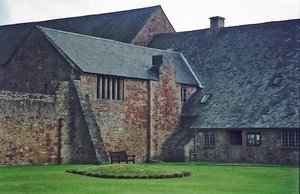Advertisement
Published: August 13th 2009

 Cleeve Abbey
Cleeve Abbey
Founded around 1190 and closed down in 1537.While driving to Bath I stop at
Cleeve Abbey, which was a Cistercian abbey founded around 1190. Cistercians were named because of their clothes of undyed wool (white monks), after Citeaux in Burgandy. Their day, beginning at 2AM, consisted of 8 or 9 periods of worship and 4 hours of work before retiring at 7pm. Theoretically they followed the values of St Benedict which was to live a simple life, do manual work and study. In practice the code wasn't always followed. For example around 1400 the Abbot and some other monks lead a band of 200 bandits. Lay brothers and peasants did most of the heavy manual work. Self sufficiency in farming and sheep had raised their material wealth, so that by the time it was closed, a result of Henry's VIII Dissolution of Monasteries Act in 1536, it was prosperous. Unfortunately spiritual purity was adversely affected. Buildings became more ornate, resembling a manor more than a monastery. The Abbot and most of the other monks where given a pension. One former monk, John Hooper, rose to prominence, only to be burnt at the stake by Queen Mary I because he was Protestant.
Now in the city of

 Roman Baths
Roman Baths
Originally established in 45AD. Current architecture dates from the 19th century. it makes sense to see the Roman Baths. Starting on England's only hot springs around 45AD, building continued over the next 400 years. As the spring was considered sacred it was not used directly. Instead water was ducted into a series of baths, the largest being the Great Bath. Also included was a hot and cool Turkish Bath. Furnace heated steam was ducted under the floors. The baths were a social center available to all, including Anglo-Saxons. People would get covered in oil, go into the cool bath, then into the hot bath, the back into the cool bath, where a slave would scrap off the oil, and finish in the plunge pool. Men and women bathed together until the sexes where separated by Emperor Hadrian. Then men went into the cool bath. After the collapse the Roman Empire, around 470AD, the baths were abandoned, and the buildings crashed into the pools. The river flooded covering it all in marsh. Saxons blocked the water and used the spring about 700AD. In 1200 a pool was built over the spring. baths were rediscovered again in the 19th century. Roman images mounted on balustrades date from this period. A museum has

 Sally Lunn Kitchen Museum
Sally Lunn Kitchen Museum
A museum displaying a kitchen of Sally's era.been constructed from parts excavated to try to display what it was like in its heyday. Many people made offerings to the Goddes Salu (Saxon) Minerva. Unearthed are coins, gemstones, staffs containing messages. Even coins from the eastern empire, which could not be used in the western empire, have been unearthed.
After leaving the Roman Baths I go to the Book Binding Museum. It is part of a shop which sells bounded books and didn't hold much interest for me. Of more interest was the
Photographic Museum which showed the story of photography from the camera obscura to the invention of roll film. Another display featured the development of the 35mm camera.
First destination, on this my second day, is the
Sally Lunn House. Built in 1482 it is the oldest in Bath. Around 1680 Sally Lunn (Solange Luyon), a Huguenot refugee, came to Bath and introduced her bun to pre-Georgian Bath. It was very popular then and continues to be so today, perhaps because of its light fluffy texture. Passed with the title deed to the house is the original and secret recipe. Inside the house, in addition to the restaurant, is the Sally Lunn Kitchen Museum,
which is a displays a kitchen of Sally's era.
Another place of interest to me is the
William Herschel Museum. It is located in a small 3-storied house, where Herschel lived, set in a series of houses. The bottom floor leading out to a garden was where he worked. It contains a model of the telescope with which he discovered Uranus and a model for a 40" reflector. Upstairs is the music room. Professionally, Herschel was an organist and composer.
Bath's main attraction is its Georgian Architecture. Being a small city allows one to engage it by walking. The driving force behind today's city of spacious squares and crescents was the father/son team of architects, both named John Wood. The circus was built be John Wood the Elder and the Royal Crescent (panorama above) by John Wood the Younger. It was a join design, the Circle representing the sun and the Crescent the moon. Most of the buildings are built with Bath stone, a warm honey coloured oolitic limestone. Pulteney Bridge was designed by Robert Adam in 1770 and completed in 1773. It serves the duel purpose of being a bridge over the Avon and a shopping mall.
Advertisement
Tot: 0.088s; Tpl: 0.01s; cc: 10; qc: 27; dbt: 0.054s; 1; m:domysql w:travelblog (10.17.0.13); sld: 1;
; mem: 1.1mb







